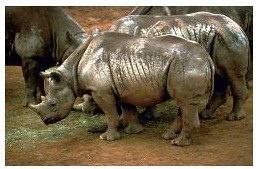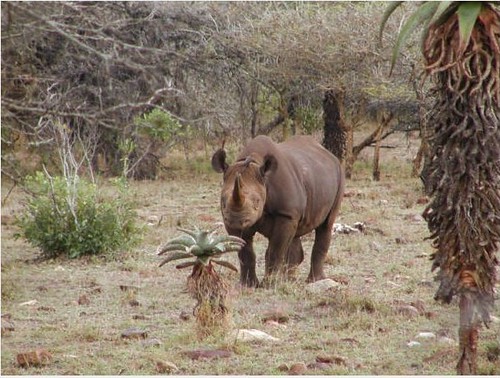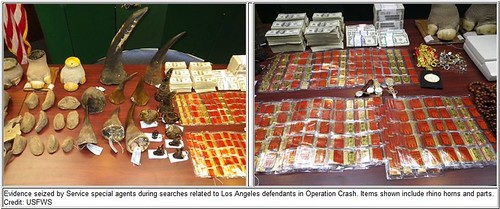
As the US Fish and Wildlife Service notes, black rhinoceros were declared endangered July 14, 1980. Despite this, Rhishja Cota-Larson (Rhino Conservation) explained last month that "668 rhinos were massacred in South Africa in 2012." Operation Crash is the name of the program the US Fish and Wildlife Service and Justice Department are operating "to investigate and prosecute those involved in the black market trade of endangered rhino horns."

Manhattan antiques dealer David Hasuman is one of those who got caught. Kevin Sheehan and Bruce Golding (New York Post) reported on the sting in which Hausman spent $8,500 for a rhino head and was then seen at a truck stop "sawing off the horns in a motel parking lot." Miguel Llanos (NBC News) explains that Hausman would use rhino "horns to make 'libation cups' and passing them off as antiques that can sell for up to $300,000."

The Justice Department details that incident and another:
In December 2010, Hausman – while purporting to help the government crack down on illegal rhinoceros trading – advised FWS that the taxidermied head of a black rhinoceros containing two horns had been illegally sold by a Pennsylvania auction house. Upon learning that the sale was not finalized, Hausman covertly purchased the rhinoceros mount himself, using a “straw buyer” to conceal that he was the true purchaser because federal law prohibits interstate trafficking in endangered species. Hausman instructed the straw buyer not to communicate with him about the matter by email to avoid creating a paper trail that could be followed by law enforcement. After the purchase was completed, Hausman directed the straw buyer to remove the horns and mail them to him. He then made a realistic set of fake horns using synthetic materials and directed the straw buyer to attach them on the rhinoceros head in order to deceive law enforcement in the event that they conducted an investigation. After his arrest, Hausman contacted the straw buyer and they agreed that the rhinoceros mount should be burned or concealed.
In a second incident, in September 2011, Hausman responded to an internet offer to sell a (different) taxidermied head of a black rhinoceros containing two horns. Unbeknownst to Hausman, the on-line seller was an undercover federal agent. Before purchasing the horns on Nov. 15, 2011, Hausman directed the undercover agent to send him an email falsely stating that the mounted rhinoceros was over 100 years old, even though the agent had told him that the rhinoceros mount was only 20 to 30 years old. There is an antique exception for certain trade in rhinoceros horns that are over 100 years old. By falsifying the age of the horns, Hausman sought to conceal his illegal conduct. Hausman also insisted on a cash transaction and told the undercover agent not to send additional emails so there would be no written record. After buying the black rhinoceros mount at a truck stop in Princeton, Ill., agents followed Hausman and observed him sawing off the horns in a motel parking lot.
Thursday Hausman was sentenced "to six months in jail for obstruction of justice and creating false records in connection with illegal rhinoceros horn trafficking." He was also ordered to make a $18,000 donation to the Rhino Tiger Conservation Fund" and $10,000 to the Lacey Act Reward Fund.

Rhinos are endangered because there are so few of them. The Rhino Foundation explains:
Today there are five species and 11 subspecies of rhinos surviving on earth. Two species (Black and White) occur in Africa. Three species (Greater One-horned rhino, Javan, and Sumatran) occur in Asia.
Thousands and especially millions of years ago, rhinos were more diverse, widespread and abundant. Rhinos occurred in North America and Europe as well as in Africa and Asia. The surviving rhinos are precious representatives of the glorious heritage and history of the rhino family on our planet.
And in terms of numbers of rhinos alive right now? The Fish and Wildlife Service notes, "African rhino populations fell by 96 percent between 1970 and 1992 and now only about 25,000 remain in the wild."

For David Hausman, rhinos were nothing but a way to make a lot of easy cash. He didn't see them as living and breathing inhabitants of the planet, he saw them only in relation to how much money their horns could bring him.

The Assistant Attorney General for the Environmental and Natural Resources Division of the Department of Justice Ignacia S. Moreno explained last week of greedy Hausman, "He posed as someone who was protecting this endangered species when he was really obtaining and using inside information to further the illegal trade in black rhino horns."
----------------
All images from the US Fish and Wildlife Service
